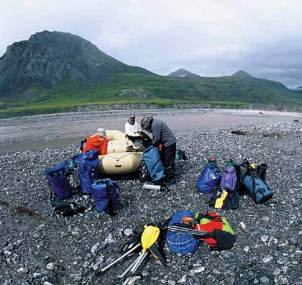Basic HTML Version



FAR FLUNG TRAVEL
STORY
FAR
-
FLUNG
TRAVEL
lagoons, salt marshes, and river deltas of the Arctic coastal tundra
provide habitat for migratory birds, including seabirds, waterfowl, and
shorebirds. Coastal plains, river valleys, and sea ice are utilized by
caribou seeking relief from mosquitoes during summer, and by polar
bears hunting seals and giving birth in snow dens during winter.
The Arctic coastal plain stretches southward from the coast to the
foothills of the Brooks Range. This area of rolling hills, small lakes and
ponds, and north-flowing, braided rivers is dominated by extensive
tundra vegetation consisting of low shrubs, sedges, and mosses.
Caribou travel to the coastal plain during June and July to give birth
and raise their teary-eyed calves. Migratory birds and insects flourish
here during the brief Arctic summer, soaking in the sun that never dips
below the horizon. Tens of thousands of snow geese stop here during
September to feed before migrating south, and shaggy musk oxen live
here year-round.
The daunting Brooks Range rises over 9,000 feet. This northernmost
extension of the Rocky Mountains marks the Continental Divide. Its north-
flowing rivers empty into the Arctic Ocean and south-flowing rivers join
the mighty Yukon River. The rugged mountains of the Brooks Range are
incised by deep river valleys, creating a range of elevations that support
a variety of low tundra vegetation, dense shrubs, rare groves of poplar
trees on the north side, and spruce on the south.
During the summer, peregrine falcons, gyrfalcons, and golden
eagles build nests on craggy cliffs. Harlequin and long-tailed ducks and
red-breasted mergansers are seen on swiftly flowing rivers. Brazen Arctic
terns made many attempts to dive-bomb us while rafting the various
rivers. Dall sheep and wolves are active all year, while grizzly bears and
Arctic ground squirrels are frequently seen during summer and hibernate
in the winter.
Alaska’s State Bird
Icy winds blowing off the Arctic Ocean were the only relief from
billions, or probably trillions, of swarming mosquitoes. Before I arrived in
the ANWR, I heard they were as big as hummingbirds. I’m not sure how
many mosquitoes I swallowed over the two weeks, but they became a
staple of my diet on the tundra. They clung to us every time we beached
our raft, making it tough to simply breathe. Our tents became our
sanctuaries, but a strategy was needed every time we climbed in or out.
I tried sprinting to my tent, then diving in. I tried ripping off my
down jacket as fast as I could, shaking it, and then getting in. Both
strategies failed miserably on nearly every attempt. It seemed like I had
a minimum of 50 mosquitoes in my tent every time I dove in or climbed
114
winter
|
spr ing

